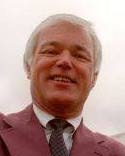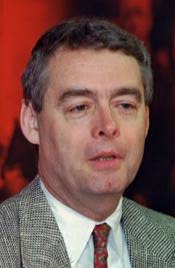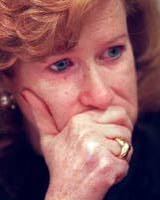The Dayton Dragons
and the long battle to bring baseball to Downtown Dayton
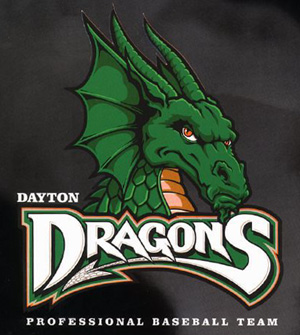 On Feb. 23, 1999 more than 500 people crammed the Crown Plaza ballroom in downtown Dayton to celebrate the announcement that final approval had been won to bring a minor league baseball team to Dayton.
On Feb. 23, 1999 more than 500 people crammed the Crown Plaza ballroom in downtown Dayton to celebrate the announcement that final approval had been won to bring a minor league baseball team to Dayton.The announcement, culminating more than two years of effort, cleared the way for the city to begin construction of a $22.7 million stadium at Patterson Blvd and Moneument Ave. The stadium will be the home playing field of a Class-A affilliate of the Cincinnati Reds.
Along the way, three separate ownership groups competed with each other and struggled through the arduous process of getting approval from Major League Baseball, Minor League Baseball and the Cincinnati Reds.
The team's name -- the "Dayton Dragons" -- was kept secret until a May 3, 1999 rally at Courthouse Square.
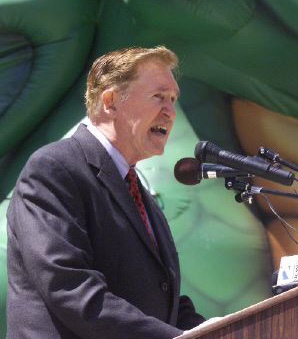 With the mascot looming over him, Hank Stickney speaks at a 5-3-99 rally at which the "Dayton Dragons" name was announced. DDN PHOTO - AIMEE OBIDZINSKI |
The owners:
The Dragons are owned by Mandalay Sports Entertainment, a division of California-based Mandalay Entertainment, which will be the majority owner. Principal investors with Mandalay include Hank Stickney, his son Ken Stickney, former Sony Pictures Chairman Peter Gruber and Mandalay Vice Chairman Paul Schaeffer. Ohio athletic notables Archie Griffin, Cris Carter and Jeff Graham are also investors. Stickney was interviewed by DDN just after the announcement.The team:
Mandalay purchased the Rockford (IL) Cubbies, a Class-A farm team of the Chicago Cubs. The team will remain in Rockford for the 1999 season as the Rockford Reds before moving to the new Dayton stadium as the Dayton Dragons for the start of the 2000 season.The stadium:
The $22.7 million stadium will be built at Patterson Boulevard and Monument Avenue on land owned by the city of Dayton. It will have 7,500 seats and room for 2,100 people on a grass berm beyond the outfield wall. There will be 24 skyboxes also. The architect is HNTB Sports Architecture of Kansas City, Mo.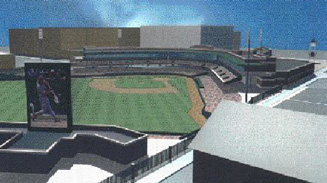 |
 |
Monument Avenue. Map shows location.
A long battle:
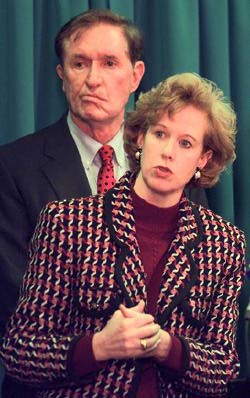 |
Rock Newman (below) was the lead owner for Sports Spectrum Sherrie Myers (right) was to be the owner in the Dayton effort, but sold to Hank Stickney (background) and the Mandalay group.
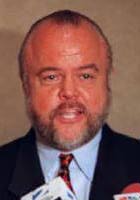 |
By the summer of 1997 the effort seemed headed for success. The Partnership had an agreement with prospective team owner Sherrie Myers who planned to buy the Rockford (Ill.) Cubbies franchise and move it to downtown Dayton.
But on Nov. 11, 1997 Myers announced at a press conference that she was giving up her efforts and would sue Major League Baseball for discrimination.
On the same day Major League Baseball issued a news release saying the Myers group "has not demonstrated it meets baseball's requirements" and that the Cincinnati Reds had given a "qualified waiver of the Dayton territory" to a rival ownership group, Sports Spectrum, fronted by boxing promoter Rock Newman.
Sports Spectrum vice president and general counsel Rich Ehrenreich said his group would purchase a team and move it to the Dayton area in time for the 1999 season.
Although Sports Spectrum considered downtown Dayton, it soon chose the Trotwood site porposed by Hara Arena manager Johnny Walker.
And then on Feb. 3, 1998 the pendulum swung again and the Dayton plan was back in the running. Myers announced she was selling her interests to Mandalay Sports Entertainment of Los Angeles. The new owners would be Mandalay CEO Hank Stickney and Archie Griffin, associate athletic director at Ohio State University.
Chronology:Oct. 17, 1996: Wright State University abandons plans to build a minor league stadium on its campus. Jan. 21, 1997: Baseball Task Force recommends acquiring a Class A minor league team and public financing of a $12 million stadium in downtown. Suggested downtown stadium sites are revealed. Feb. 28, 1997: Cities and townships surrounding Dayton support the idea of a $4 million Economic Development/ Government Equity grant to help fund the stadium. March 4, 1997: Downtown Dayton Partnership estimates the stadium will cost $20 million and a Class A team another $5 million. March 27, 1997: Owners of the Lansing (Mich.) Lugnuts - Tom Dickson and Sherrie Myers - announce they plan to own and operate a team in Dayton.
April, 1997: Some Oregon Historic District residents oppose a stadium near their neighborhood. Meanwhile, Dickson and Myers change their plans to buy a team in the South Atlantic League after Cincinnati Reds officials indicate Dayton is too far from that league. The husband and wife team begin shopping for a team in the Midwest League. June 3, 1997: Reds officials agree to waive their territorial rights to allow a team in downtown Dayton if funding commitments are made, team owners agree to market the team with the Reds and owners get approval from the Midwest League and Major League Baseball. June 16, 1997: The Partnership announces a stadium site at First Street and River Corridor Drive. July 2, 1997: Dayton City Commission votes 4-1 to bankroll the $20 million project until funding from county, state, federal and private sources comes through. The commission agrees to issue up to $13 million in bonds for the project. July 24, 1997: Boxing promoter Rock Newman raises questions about Dickson and Myers each owning a team in the Midwest League and whether that violates rules against dual ownership. Newman, who says he has friends in Major League Baseball, also said he would be willing to step in and run a team in Dayton. August, 1997: Some environmental and water table problems at the stadium site are discovered and force the city to consider a different, more costly design. Costs increase $2.7 million to $22.7 million. Midwest League approves Myers' application to purchase the Rockford (Ill.) Cubbies and move them to Dayton for the 1999 season. Sept. 10, 1997: The city authorizes the stadium land purchase but staff members hold off, awaiting Major League Baseball approval. Sept. 17, 1997: Myers' application is forwarded to Major League Baseball. Oct., 1997: Reds officials say they will work with whatever team is approved by Major League Baseball. Myers sets Oct. 15 and Oct. 24 as deadlines to hear from Major League officials. League officials miss the deadlines and say they will make a decision sometime after the World Series.
Nov. 11, 1997: At an emotional press conference Myers says she'll stop her efforts to bring minor league baseball to Dayton and will sue Major League Baseball because she feels she is a victim of reverse discrimination. Major League Baseball gives preliminary approval to Sports Spectrum to bring a team here. Dec. 10, 1997: Sports Spectrum announces an agreement with Trotwood to build a stadium near Hara Arena. Feb. 3, 1998 -- Myers announces she has sold her Dayton interests to Mandalay Sports Entertainment of Los Angeles. Mandalay CEO Hank Stickney would be the lead owner along with former football great Archie Griffin. Feb. 6, 1998 -- Investors in the Trotwood project filed a $51 million lawsuit against the Dayton group and the city of Dayton. March 12, 1998: Mandalay files a $225 million countersuit. March 13, 1998 -- The Midwest League announces that Sports Spectrum had withdrawn its application to bring a team to Trotwood. May 13, 1998: Dayton City Commissioners unanimously approve up to $18.5 million bond sale to finance a baseball stadium, and agrees to a 15-year lease with Mandalay and approves spending $607,000 for an environmental cleanup of the site. June 1, 1998: Deadline for the start of downtown stadium construction passes without work being started. June 17, 1998: City Commission splits over whether to require union labor for stadium construction after heated debate between unions and local contractors. The measure fails. June 22, 1998: Midwest League approves Mandalay's proposal to buy the Rockford Cubbies and move the team to Dayton. July/August, 1998: Two rounds of stadium construction bids fail to bring in a bid for less than the $16 million proposed cost. City officials concede team cannot begin playing in Dayton until 2000 at the earliest. Mandalay agrees to build stadium itself with help from an $11.3 million loan from the city once Major League Baseball approves. Dec. 21, 1998: Cincinnati Reds give Mandalay permission to bring a Class-A team to Dayton. Feb. 23, 1999: Major League Baseball approval announced. May 3, 1999: At a rally on Courthouse Square team officials unveiled the "Dayton Dragons" name and mascot. |
Selected stories on baseball in Dayton:NEW GROUP TO TRY FOR BALLCLUB September 18, 1996 ; By Susan Vinella
TASK FORCE: PLAY BALL;
CITY URGED TO GET TEAM, STADIUM
DAYTON TEAM ON DECK
COMMENTARY
MYERS STRIKES OUT;
CITY'S BACK IN BALLGAME
BASEBALL GROUP HAS OHIO TIES
CITY'S BACK IN BALLGAME
HARA'S OUT, FOR NOW
BASEBALL
FINALLY, BASEBALL'S AT HOME IN DAYTON
|
Stories on the history of
DAYTON'S RICH BASEBALL HERITAGE REMEMBERED |
Click below to generate a search on the electronic library
|
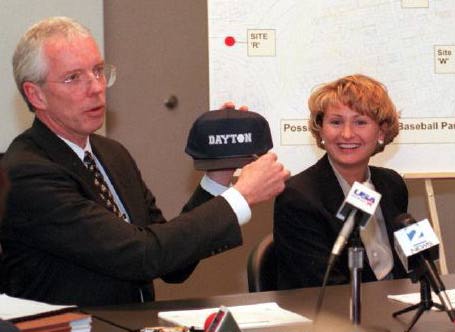
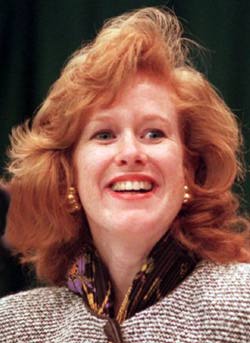 team investor. Myers secured an
option to buy the Class A Rockford (Ill.) Cubbies and move it to a stadium at
the edge of downtown Dayton. Her plan was approved by the team's Midwest
League and by the governing body of minor league baseball, but stalled when
sent to Major League Baseball.
team investor. Myers secured an
option to buy the Class A Rockford (Ill.) Cubbies and move it to a stadium at
the edge of downtown Dayton. Her plan was approved by the team's Midwest
League and by the governing body of minor league baseball, but stalled when
sent to Major League Baseball.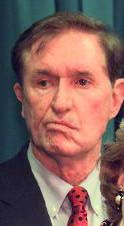 is a partner in the group. Mandalay bought the Dayton sports corporation formed by Myers to bring the Rockford
club to Dayton.
is a partner in the group. Mandalay bought the Dayton sports corporation formed by Myers to bring the Rockford
club to Dayton.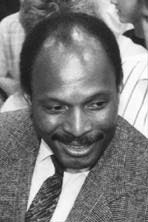 Archie Griffin , two-time Heisman Trophy winner at Ohio State University
and former Cincinnati Bengals running back. Griffin,
now Ohio State's associate athletics director, will be a minority owner in the Dayton team.
Archie Griffin , two-time Heisman Trophy winner at Ohio State University
and former Cincinnati Bengals running back. Griffin,
now Ohio State's associate athletics director, will be a minority owner in the Dayton team.